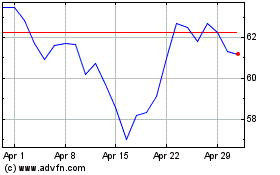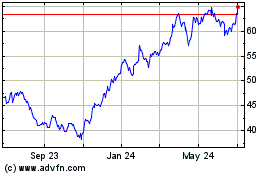After profit declines for two straight quarters,
JPMorgan Chase & Company (JPM) reported first
quarter earnings per share of $1.31, topping the Zacks Consensus
Estimate of $1.17. This also compares favorably with $1.28 earned
in the prior-year quarter. That’s more like the JPMorgan we have
always known.
JPMorgan’s better-than-expected earnings signals good going by
the sector as it has exposure in almost all banking businesses.
Marked recovery of the bond and equity market and consequent
revenue growth, which helped JPMorgan to bounce back, should lift
the results of other mega-banks during the quarter.
JPMorgan’searnings per share for the reported quarter included
certain significant nonrecurring items, such as after-tax benefit
from reduced loan loss reserves of 28 cents per share, after-tax
benefit from the Washington Mutual bankruptcy settlement of 17
cents, after-tax expense for additional litigation reserves of 39
cents and after-tax loss from debit valuation adjustment (DVA) in
the Investment Bank of 14 cents. Excluding these items, JPMorgan’s
earnings came in at $1.39 per share.
Results for the reported quarter were primarily benefited by
improved revenue and slowdown in provision for credit losses, which
more than offset higher non-interest expense. Almost all the
sectors except Corporate/Private Equity performed well to result in
such impressive earnings during the quarter.
Investment banking results witnessed a drastic deterioration
from the prior-year quarter due to lower revenue and lower benefit
from the provision for credit losses. However, the results were
much better than the prior quarter due to improved market
conditions. However, with a healthy market share, the segment
maintained its #1 rank in Global Investment Banking Fees.
Retail Financial Services and Commercial Banking divisions
demonstrated good underlying performances, with improved revenue
and earnings. However, despite positive credit trends for credit
card portfoliosand an expansion in credit card sales volume, the
overall performance of the Card business was not very impressive.
Treasury & Securities Services reported higher deposit balances
during the quarter and performed better than the prior and
prior-year quarters.
Quarter in Detail
Managed net revenue of $27.4 billion in the quarter was up 6%
from the year-ago quarter. The figure also compares favorably with
the Zacks Consensus Estimate of $24.4 billion.
Managed non-interest revenue increased 13% from the year-ago
period to $15.6 billion. The increase was a result of higher
mortgage fees and related income, and a benefit from the Washington
Mutual bankruptcy settlement, partially offset by lower principal
transaction revenue. However, net interest income was down 2% from
the year-ago quarter at $11.8 billion.
Non-interest expenses were $18.3 billion, up 15% from the
year-ago quarter. The increase was primarily due to higher
compensation and non-compensation expenses.
Managed provision for credit losses decreased 38% from the
year-ago quarter to $726 million. Total consumer provision for
credit losses was $637 million, down 31% from $918 million in the
year-ago quarter. This reflects improved delinquency trends across
most consumer portfolios compared with the prior-year quarter.
Credit Quality
JPMorgan’s credit quality showed a decent improvement during the
quarter. As of March 31, 2012, nonperforming assets were $11.7
billion, slightly up from $11.0 billion in the prior quarter but
down from $15.0 billion in the prior-year quarter.
Consumer net charge-offs decreased to $2.4 billion from $3.6
billion in the prior-year quarter. As a result, the consumer net
charge-off rate improved to 2.60% from 3.77% a year ago.
Capital Position
JPMorgan maintained a strong capital position with Basel I Tier
1 common ratio of 10.4% as of March 31, 2012, up from 10.1% as of
December 31, 2011 and 10.0% as of March 31, 2011. The estimated
Basel III Tier 1 common ratio was approximately 8.4% as of March
31, 2012.
Book value per common share was $47.60 as of March 31, 2012,
compared with $46.59 as of December 31, 2011 and $43.34 as of March
31, 2011.
Our Viewpoint
JPMorgan was not able to deliver impressive results in the last
two quarters of 2011 as it buckled under the weakness in the wider
economy and the fundamental pressures on the sector, but it
overcame its shortcomings with the help of gradually improving
macroeconomic elements, such as rising consumer spending and higher
employment.
However, JPMorgan has been fighting poor capital market
revenues, low liquidity and a tough regulatory environment, which
might mar its results in the upcoming quarters. On the other hand,
reduction in reserves for future losses, gradually improving retail
banking performance and steady credit trends in its credit card
business are expected to be on the positive side going
forward.
Most importantly, despite the macro pressure on credit quality,
JPMorgan’s credit metrics have been steadily improving since the
final quarter of 2009. Though provisions continued to reflect
elevated losses in the mortgage and home equity portfolios, we are
impressed to see a modest improvement in delinquency trends and net
charge-offs. We expect credit quality to continue improving,
thereby providing more room for bottom-line improvement.
Though there are concerns related to its exposure to the
European economy, equity-centric activities in the U.S. are
expected to support JPMorgan’s results in the upcoming quarters
with continued recovery in the capital markets.
Yet net interest income remains under pressure, affecting the
traditional banking businesses. Also, with the thrust of new
banking regulations, there will be pressure on fees, and loan
growth could remain feeble.
In Conclusion
An investor with an appetite to absorb risks related to market
volatility should not be disappointed with an investment in
JPMorgan over the long haul. Though the stock is not trading for
less than what it is worth, JPMorgan’s fundamentals remain highly
promising with a diverse business model and a strong balance
sheet.
Also, from the risk perspective, as JPMorgan cleared the most
difficult stress test, it is for sure that the company would be
able to withstand another financial crisis.
Moreover, one can consider a company like JPMorgan as value
investment due to its steady dividend-yielding nature. The company
announced a 20% increase in its quarterly dividend to 30 cents per
share. This is the second time that JPMorgan hiked its dividend
since the financial crisis. Prior to this, the company had
increased its quarterly dividend five-fold to 25 cents in March
2011.
JPMorgan shares maintain a Zacks #2 Rank, which translates into
a short-term Buy rating. However, we maintain a long-term
Neutral recommendation on the stock.
Following the announcement of first quarter results, the stock
was up about 0.25% in before-market trade.
As JPMorgan is a banking giant with exposure in almost all
banking businesses and is one of the first two important bankers to
kick start first quarter results, its results are going to be a
significant indicator of performances in the key banking sector.
Wells Fargo & Company (WFC) has advanced its
earnings release date this quarter by about a week and reported on
the same day with JPMorgan.
Close on the heels of JPMorgan and Wells Fargo, the other major
banks, namely Citigroup Inc. (C) is scheduled to
report on April 16, Goldman Sachs Group Inc. (GS)
on April 17, and Bank of America Corporation (BAC)
and Morgan Stanley (MS) on April 19.
BANK OF AMER CP (BAC): Free Stock Analysis Report
CITIGROUP INC (C): Free Stock Analysis Report
GOLDMAN SACHS (GS): Free Stock Analysis Report
JPMORGAN CHASE (JPM): Free Stock Analysis Report
MORGAN STANLEY (MS): Free Stock Analysis Report
WELLS FARGO-NEW (WFC): Free Stock Analysis Report
To read this article on Zacks.com click here.
Zacks Investment Research
Citigroup (NYSE:C)
Historical Stock Chart
From Mar 2024 to Apr 2024

Citigroup (NYSE:C)
Historical Stock Chart
From Apr 2023 to Apr 2024
